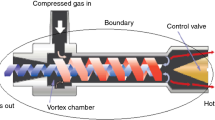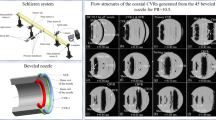Abstract
This study aims to determine the relationship between the physical features of a compressible vortex and the mixing process. Such relationship is of significant importance to design combustors that can achieve optimal or most effective mixing. The passive scalar mixing induced by the formation of a canonical compressible vortex ring (CVR) generated at the end of a shock tube is investigated by using numerical simulation. In addition, the method of finite-time Lyapunov exponent (FTLE) field are detected to identify the region of CVR, as well as to analyze the passive scalar mixing during the CVR formation. As the CVR rolls up, the ambient fluid outside the shock tube is entrained into the ring. The entrainment fraction (the mass of entrained fluid to the total mass of CVR) is found to strongly depend on two features of CVRs. One is the compressibility of CVRs, which is characterized by the Mach number of the incident shock denoted by Mach number (Ma). The other is pinch-off of CVRs, which happens at a certain timescale with narrow range of 2–4. As Ma increases, the entrainment fraction of the leading CVR decreases linearly due to smaller vortex core and weaker radial diffusion of vorticity generated by larger compressibility. After CVRs pinch off, trailing vortices appear and show less effective at entrainment than the leading CVRs do. Moreover, the tendency of the rate of entrainment is examined. The results indicate that increasing compressibility and total fluid flux are in favor of the rate of entrainment but restrain the entrainment fraction of total jet.
Graphic abstract























Similar content being viewed by others
References
Shariff, K., Leonard, A.: Vortex rings. Annu. Rev. Fluid Mech. 24, 235–279 (1992)
Buch, K.A., Dahm, W.J.A.: Experimental study of the fine-scale structure of conserved scalar mixing in turbulent shear flows. Part 1 Sc ≫ 1. J. Fluid Mech. 317, 21–71 (1996)
de Sousa, P.J., Pereira, J.C.: Dynamics of passive scalars and tracers advected by a two-dimensional tripolar vortex. J. Fluid Mech. 634, 41–60 (2009)
Flohr, P., Vassilicos, J.C.: Accelerated scalar dissipation in a vortex. J. Fluid Mech. 348, 295–317 (1997)
Hermanson, J.C., Cetegen, B.M.: Shock-induced mixing of nonhomogeneous density turbulent jets. Phys. Fluids 12, 1210–1225 (2000)
Duplat, J., Villermaux, E.: Mixing by random stirring in confined mixtures. J. Fluid Mech. 617, 51–86 (2008)
Shadden, S.C., Katija, K., Rosenfeld, M., et al.: Transport and stirring induced by vortex formation. J. Fluid Mech. 593, 315–331 (2007)
Maxworthy, T.: The structure and stability of vortex rings. J. Fluid Mech. 51, 15–32 (1972)
Muller, E.A., Didden, N.: Zur erzeugung der zirkulation bei der bildung eines ringwirbels an einer dusenmundung. Stroj. Casop 31, 363–372 (1980)
Dabiri, J.O., Gharib, M.: Fluid entrainment by isolated vortex rings. J. Fluid Mech. 511, 311–331 (2004)
Olcay, A.B., Krueger, P.S.: Measurement of ambient fluid entrainment during laminar vortex ring formation. Exp. Fluids 44, 235–247 (2007)
Gharib, M., Rambod, E., Shariff, K.: A universal time scale for vortex ring formation. J. Fluid Mech. 360, 121–140 (1998)
Sau, R., Mahesh, K.: Passive scalar mixing in vortex rings. J. Fluid Mech. 582, 449–461 (2007)
Liang, G., Yu, B., Zhang, B., et al.: Hidden flow structures in compressible mixing layer and a quantitative analysis of entrainment based on Lagrangian method. J. Hydrodyn. 31, 256–265 (2019)
Dimotakis, P.E.: Two-dimensional shear-layer entrainment. AIAA J. 24, 1791–1796 (1986)
Wonhas, A., Vassilicos, J.C.: Mixing in frozen and time-periodic two-dimensional vortical flows. J. Fluid Mech. 442, 359–385 (2001)
Cetegen, B.M., Hermanson, J.C.: Mixing characteristics of compressible vortex rings interacting with normal shock waves. Combust. Flame 100, 232–240 (1995)
Li, D., Guan, B., Wang, G.: Numerical study on shock-accelerated heavy gas cylinders with diffusive interfaces. Acta Mech. Sin. 35, 750–762 (2019)
Chen, X., Dong, G., Li, B.: Numerical study of three-dimensional developments of premixed flame induced by multiple shock waves. Acta Mech. Sin. 34, 1035–1047 (2018)
Zhang, S., Zhang, Y., Shu, C.W.: Multistage interaction of a shock wave and a strong vortex. Phys. Fluids 17, 116101 (2005)
Zhang, S., Zhang, H., Shu, C.W.: Topological structure of shock induced vortex breakdown. J. Fluid Mech. 639, 343–372 (2009)
Heister, S.D., Mcdonough, J.M., Karagozian, A.R., et al.: The compressible vortex pair. J. Fluid Mech. 220, 339–354 (1990)
Brouillette, M., Hebert, C.: Propagation and interaction of shock-generated vortices. Fluid Dyn. Res. 21, 159–169 (1997)
Dora, C.L., Murugan, T., De, S., et al.: Role of slipstream instability in formation of counter-rotating vortex rings ahead of a compressible vortex ring. J. Fluid Mech. 753, 29–48 (2014)
Qin, L., Xiang, Y., Lin, H., et al.: Formation and dynamics of compressible vortex rings generated by a shock tube. Exp. Fluids 61, 86 (2020)
Haller, G., Yuan, G.: Lagrangian coherent structures and mixing in two-dimensional turbulence. Phys. D 147, 352–370 (2000)
Haller, G.: A variational theory of hyperbolic Lagrangian coherent structures. Phys. D 240, 574–598 (2010)
Haller, G.: Lagrangian coherent structures. Annu. Rev. Fluid Mech. 47, 137–162 (2014)
Kontis, K., An, R., Edwards, J.A.: Compressible vortex-ring interaction studies with a number of generic body configurations. AIAA J. 44, 2962–2978 (2006)
Kruegera, P.S., Gharib, M.: The significance of vortex ring formation to the impulse and thrust of a starting jet. Phys. Fluids 15, 1271–1281 (2003)
Murugan, T., De, S., Dora, C.L., et al.: Numerical simulation and PIV study of compressible vortex ring evolution. Shock Waves 22, 69–83 (2011)
Xiang, Y., Lin, H., Zhang, B., et al.: Quantitative analysis of vortex added-mass and impulse generation during vortex ring formation based on elliptic Lagrangian coherent structures. Exp. Therm Fluid Sci. 94, 295–303 (2018)
Qin, S., Liu, H., Xiang, Y.: On the formation modes in vortex interaction for multiple co-axial and co-rotating vortex rings. Phys. Fluids 30, 011901 (2018)
Zhang, M., Wu, Q., Huang, B., et al.: Lagrangian-based numerical investigation of the aerodynamic performance for an oscillating foil. Acta. Mech. Sin. 34, 839–854 (2018)
Wu, Q., Huang, B., Wang, G.: Lagrangian-based investigation of the transient flow structures around a pitching hydrofoil. Acta Mech. Sin. 32, 64–74 (2015)
O’Farrell, C., Dabiri, J.O.: A Lagrangian approach to identifying vortex pinch-off. Chaos 20, 017513 (2010)
Wang, L., Feng, L.H., Wang, J.J., et al.: Characteristics and mechanism of mixing enhancement for noncircular synthetic jets at low Reynolds number. Exp. Therm. Fluid Sci. 98, 731–743 (2018)
Perez-Munuzuri, V.: Mixing and clustering in compressible chaotic stirred flows. Phys. Rev. E 89, 022917 (2014)
Perez-Munuzuri, V.: Clustering of inertial particles in compressible chaotic flows. Phys. Rev. E 91, 052906 (2015)
Green, M.A., Rowley, C.W., Smits, A.J.: Using hyperbolic Lagrangian coherent structures to investigate vortices in bioinspired fluid flows. Chaos 20, 017510 (2010)
Sun, M., Takayama, K.: Vorticity production in shock diffraction. J. Fluid Mech. 478, 237–256 (2003)
Ishii, R., Fujimoto, H., Hatta, N., et al.: Experimental and numerical analysis of circular pulse jets. J. Fluid Mech. 392, 129–153 (1999)
Lawson, J.M., Dawson, J.R.: The formation of turbulent vortex rings by synthetic jets. Phys. Fluids 25, 105113 (2013)
Schlueter-Kuck, K., Dabiri, J.O.: Pressure evolution in the shear layer of forming vortex rings. Phys. Rev. Fluids 1, 012501 (2016)
Gao, L., Yu, S.C.M.: Development of the trailing shear layer in a starting jet during pinch-off. J. Fluid Mech. 700, 382–405 (2012)
Shusser, M., Rosenfeld, M., Dabiri, J.O., et al.: Effect of time-dependent piston velocity program on vortex ring formation in a piston/cylinder arrangement. Phys. Fluids 18, 033601 (2006)
Gao, L., Yu, S.C.M.: A model for the pinch-off process of the leading vortex ring in a starting jet. J. Fluid Mech. 656, 205–222 (2010)
Krueger, P.S., Dabiri, J.O., Gharib, M.: The formation number of vortex rings formed in uniform background co-flow. J. Fluid Mech. 556, 147–166 (2006)
Dabiri, J.O., Gharib, M.: Starting flow through nozzles with temporally variable exit diameter. J. Fluid Mech. 538, 111–136 (2005)
Thangadurai, M., Das, D.: Characteristics of counter-rotating formed ahead of a compressible vortex ring. Exp. Fluids 49, 1247–1261 (2010)
Saffman, P.G.: The velocity of viscous vortex rings. Stud. Appl. Math. 49, 371–380 (1970)
Weigand, A., Gharib, M.: On the evolution of laminar vortex rings. Exp. Fluids 22, 447–457 (1997)
Arakeri, J.H., Das, D., Krothapalli, A., et al.: Vortex ring formation at the open end of a shock tube: a particle image velocimetry study. Phys. Fluids 16, 1008–1019 (2004)
Acknowledgements
We wish to acknowledge the support of the National Natural Science Foundation of China (NSFC) Project (Grant 91441205) and the National Science Foundation for Young Scientists of China (Grant 51606120). Besides, the authors would like to thank the Center for High Performance Computing of SJTU for providing the super computer \( \pi \) to support this research.
Author information
Authors and Affiliations
Corresponding author
Rights and permissions
About this article
Cite this article
Lin, H., Xiang, Y., Xu, H. et al. Passive scalar mixing induced by the formation of compressible vortex rings. Acta Mech. Sin. 36, 1258–1274 (2020). https://doi.org/10.1007/s10409-020-01006-6
Received:
Revised:
Accepted:
Published:
Issue Date:
DOI: https://doi.org/10.1007/s10409-020-01006-6




